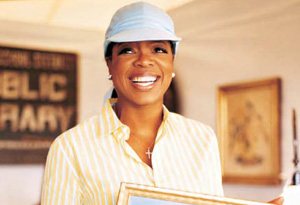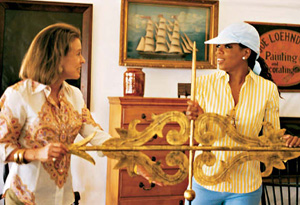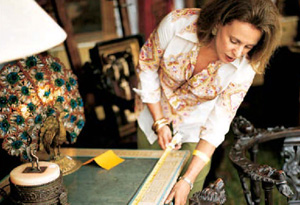Oprah Goes for the Old

Photo: Rob Howard
Oprah and decorator Ellie Cullman shopped for weather vanes, paintings, ceramics (and ice cream cones) at an antiques fair in Connecticut. Find out how to get the best deal if you're in the market for a little folk art.
It's 7:45 a.m. on a steamy Saturday morning in June, and Oprah's interior designer Ellie Cullman is scurrying to finish her homework. Cramming like a college student before final exams, she is studying the floor plans, fabric swatches and photographs that she keeps in a massive three-ring binder. She's reviewing every item that's already been purchased for the house Oprah is renovating in Hawaii, because the two women have to stay focused when they go shopping today at the Wilton Outdoor Antiques Marketplace in southern Connecticut. Oprah has decided to furnish her new home with folk art—decorative objects made by artisans with little or no formal training—and she's become quite the connoisseur.Before Oprah arrives, Ellie wants to identify the booths that have the best merchandise. Ellie looks at her watch and worries that she won't get to preview all 144 booths before Oprah arrives. Nevertheless, the list of items that she's confident Oprah will want grows quickly: a worn wooden sign from a public library, a scrimshaw horse, a pair of shiny brass sconces, a stack of Shaker boxes in a rainbow of colors, a rooster weather vane.
"Hi, Ellie-belly!" Oprah says as she and her best friend Gayle King step out of her car. "We're ready to spend some money!" While museum-quality pieces can have "painful" price tags, shopping for folk art is fun. "It's accessible and affordable," says Oprah, who's not enamored of highfalutin furniture or knickknacks with pedigrees. "The dealers who tell me who had it, where it came from—I don't care. I only care that I like it."

Photo: Rob Howard
Tramping around a field of antiques dealers in the noonday sun is tiring, so Ellie and Oprah stop for a pick-me-up at an ice cream truck parked on the grass. Fueled by a sugar high, Oprah becomes more decisive. "I must have that!" she says of the 1920 hand-carved public library sign that Ellie measured earlier in the day and knows will fit on a wall in the reading nook. "Aren't you going to ask how much it is?" Gayle wonders, but Oprah has already turned her attention to a humble early-20th-century painting of four young African-American women standing on a country road. "It's so rare that you see anything black that I must have it," she says. "Girls," she continues, studying the young women on the canvas, "you're coming to my house!"
When Ellie suggests buying vintage tin stars to hang on the walls of the porch, Oprah shakes her head. "I'm not feelin' it," she says and walks to the next booth, where she and Ellie can't make up their minds about a white porcelain planter that could be used as a centerpiece on the dining-room table. "Doubt means don't," she tells Ellie, "whether it's a man, a table or a pair of shoes."
By following her own dictum and staying true to her taste, Oprah is sure she hasn't made any mistakes today. "I have the best feeling," she says, "no buyer's remorse!"
When Ellie suggests buying vintage tin stars to hang on the walls of the porch, Oprah shakes her head. "I'm not feelin' it," she says and walks to the next booth, where she and Ellie can't make up their minds about a white porcelain planter that could be used as a centerpiece on the dining-room table. "Doubt means don't," she tells Ellie, "whether it's a man, a table or a pair of shoes."
By following her own dictum and staying true to her taste, Oprah is sure she hasn't made any mistakes today. "I have the best feeling," she says, "no buyer's remorse!"

Photo: Rob Howard
Rules for Antiquing
By Oprah's interior designer Ellie Cullman
1. Call the organizers in advance and ask for a map of the fair's layout. Locate favorite vendors and plan to visit them first.
2. Arrive at the show before it opens, even if you have to wait in line for admission. You want to be one of the first visitors to each booth. There's nothing worse than seeing a sold tag on a piece that you love.
3. Bring accurate measurements of your rooms so you can check whether a table, chair or painting is the right size before buying it.
4. Bring a pen, paper and a tape measure. Write down the price, description and size of the pieces you are considering so you can remember what your options are as you go through the show.
5. Bring a digital camera to take pictures of the things you are interested in but not sure about.
6. Get the dealers' cell phone numbers. After you've gone through the show once, take a look at the digital pictures, descriptions and prices of pieces you liked. When you're ready to buy, you can call the vendors to see if the pieces you'd like to purchase are still for sale.
7. Bring a checkbook and photo ID. Many dealers don't take credit cards.
8. If you're looking for big pieces, ask if they can arrange for shipping and how expensive that will be. Renting or borrowing a van may be a better way to get your pieces home.
Shopping: The Master Class
Nate's rules for flea market deals
How to make yourself a supershopper
Anthropologie style: Globe-trotting shopping secrets
By Oprah's interior designer Ellie Cullman
1. Call the organizers in advance and ask for a map of the fair's layout. Locate favorite vendors and plan to visit them first.
2. Arrive at the show before it opens, even if you have to wait in line for admission. You want to be one of the first visitors to each booth. There's nothing worse than seeing a sold tag on a piece that you love.
3. Bring accurate measurements of your rooms so you can check whether a table, chair or painting is the right size before buying it.
4. Bring a pen, paper and a tape measure. Write down the price, description and size of the pieces you are considering so you can remember what your options are as you go through the show.
5. Bring a digital camera to take pictures of the things you are interested in but not sure about.
6. Get the dealers' cell phone numbers. After you've gone through the show once, take a look at the digital pictures, descriptions and prices of pieces you liked. When you're ready to buy, you can call the vendors to see if the pieces you'd like to purchase are still for sale.
7. Bring a checkbook and photo ID. Many dealers don't take credit cards.
8. If you're looking for big pieces, ask if they can arrange for shipping and how expensive that will be. Renting or borrowing a van may be a better way to get your pieces home.
Shopping: The Master Class
Nate's rules for flea market deals
How to make yourself a supershopper
Anthropologie style: Globe-trotting shopping secrets



